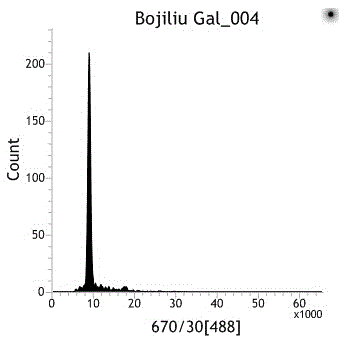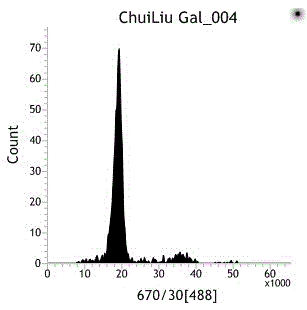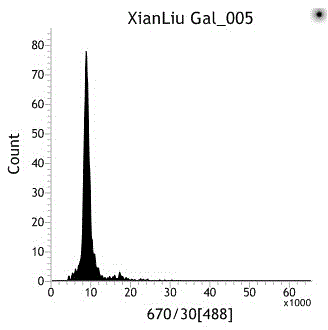Method for rapid identification of ploidy of salicaceae plant
A willow, rapid technology, applied in the biological field, to achieve the effect of simple preparation method, high resolution and reliable technical means
- Summary
- Abstract
- Description
- Claims
- Application Information
AI Technical Summary
Problems solved by technology
Method used
Image
Examples
Embodiment 1
[0033] Embodiment 1 weeping willow ( Salixbabylonica ) ploidy identification
[0034] The young leaves of the weeping willow to be tested were collected from Xuanwu Lake Park in Nanjing, and the diploid dustpan willow ( S. suchowensis ) for the control. Before the experiment, collect fresh young leaves, wrap them in wet filter paper and bring them back, store them in a refrigerator at 4°C, and use them within 3 days.
[0035] (1) Preparation of nucleus extraction buffer
[0036] The nucleus extraction buffer was prepared according to the following components and ratios: 0.5mM spermine tetrahydrochloride, 30mM sodium citrate, 200mM Tris, 80mM potassium chloride, 0.5% (v / v) TritonX-100. Adjust the pH to 7.5 with 1M hydrochloric acid or 1M sodium hydroxide, and store at 4°C.
[0037] (2) Preparation of nuclei staining buffer
[0038] Dissolve 1 mg of propidium iodide (PI) powder in 1 mL of deionized water to prepare a 1 mg / mL PI stock solution and store at 4°C.
[0039] (...
Embodiment 2
[0047] Embodiment 2 Chinese wolfberry ( S. integra ) ploidy identification
[0048] The sample to be tested willow willow is a hydroponic seedling, which comes from the germplasm resource nursery of Nanjing Forestry University in Chenxu Forest Farm, Sihong, Jiangsu. The diploid glandular willow ( S. chaenomeloides ) for the control.
[0049] (1) Preparation of nucleus extraction buffer
[0050] The nucleus extraction buffer was prepared according to the following components and ratios: 0.5mM spermine tetrahydrochloride, 30mM sodium citrate, 200mM Tris, 80mM potassium chloride, 0.5% (v / v) TritonX-100. Adjust the pH to 7.5 with 1M hydrochloric acid or 1M sodium hydroxide, and store at 4°C.
[0051] (2) Preparation of nuclei staining buffer
[0052] Dissolve 1 mg of propidium iodide (PI) powder in 1 mL of deionized water to prepare a 1 mg / mL PI stock solution and store at 4°C.
[0053] (3) Preparation of cell nucleus suspension
[0054] Take 30~50 mg of fresh young leaves...
Embodiment 363
[0061] Example 363 poplar ( Populus deltides ‘Harvord’) ploidy determination
[0062] Sample 63 poplar to be tested came from the campus of Nanjing Forestry University, and the young leaves of its branches were collected as the test material. The diploid Populus tomentosa ( P. tomentosa ) for the control.
[0063] (1) Preparation of nucleus extraction buffer
[0064] The nucleus extraction buffer was prepared according to the following components and ratios: 0.5mM spermine tetrahydrochloride, 30mM sodium citrate, 200mM Tris, 80mM potassium chloride, 0.5% (v / v) TritonX-100. Adjust the pH to 7.5 with 1M hydrochloric acid or 1M sodium hydroxide, and store at 4°C.
[0065] (2) Preparation of nuclei staining buffer
[0066] Dissolve 1 mg of propidium iodide (PI) powder in 1 mL of deionized water to prepare a 1 mg / mL PI stock solution and store at 4°C.
[0067] (3) Preparation of cell nucleus suspension
[0068] Take 30~50 mg of fresh young leaves, wash the dust on the surfa...
PUM
 Login to View More
Login to View More Abstract
Description
Claims
Application Information
 Login to View More
Login to View More - R&D
- Intellectual Property
- Life Sciences
- Materials
- Tech Scout
- Unparalleled Data Quality
- Higher Quality Content
- 60% Fewer Hallucinations
Browse by: Latest US Patents, China's latest patents, Technical Efficacy Thesaurus, Application Domain, Technology Topic, Popular Technical Reports.
© 2025 PatSnap. All rights reserved.Legal|Privacy policy|Modern Slavery Act Transparency Statement|Sitemap|About US| Contact US: help@patsnap.com



